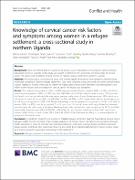| dc.contributor.author | Adoch, Winnie | |
| dc.contributor.author | Garimoi, Orach Christopher | |
| dc.contributor.author | Scott, E.Suzanne | |
| dc.contributor.author | Okeny, Goddie Geoffrey | |
| dc.contributor.author | Moodley, Jennifer | |
| dc.contributor.author | Komakech, Henry | |
| dc.contributor.author | Walter, M. Fiona | |
| dc.contributor.author | Mwaka, Amos Deogratius | |
| dc.date.accessioned | 2021-04-29T08:01:40Z | |
| dc.date.available | 2021-04-29T08:01:40Z | |
| dc.date.issued | 2020-12-03 | |
| dc.identifier.citation | Adoch, W., Garimoi, C.O., Scott, S.E., Okeny, G.G., Moodley, J., Komakech, H., Walter, F.M. and Mwaka, A.D., 2020. Knowledge of cervical cancer risk factors and symptoms among women in a refugee settlement: a cross-sectional study in northern Uganda. Conflict and Health, 14(1), pp.1-9. | en_US |
| dc.identifier.issn | 1752-1505 | |
| dc.identifier.uri | http://hdl.handle.net/20.500.12280/2786 | |
| dc.description.abstract | Background: There are limited data on awareness of cervical cancer risk factors and symptoms among refugee populations living in Uganda. In this study, we sought to determine the awareness and knowledge of cervical cancer risk factors and symptoms among women in Palabek refugee settlement, northern Uganda.
Methods: We conducted a cross-sectional study. 815 women (aged 18–60 years) were randomly selected using multistage sampling in Palabek refugee settlement. Data were collected using pre-tested, structured questionnaires. Logistic regression models were used to determine magnitudes of association between socio-demographic and health system factors, and knowledge on cervical cancer risk factors and symptoms.
Results: The majority of participants (53%, n = 433) were young (18–29 years), married (68%, n = 553), and did not have formal employment (93%, n = 759). Less than half (40%, n = 325) had heard of cervical cancer. Of those who had heard, most recognized multiple male sexual partners, early onset of sexual intercourse and HPV infections as risk factors for cervical cancer (93%, n = 295; 89%, n = 283; and 86%, n = 271 respectively). Median knowledge score for risk factor recognition = 7 (IQR: 3–9). Median knowledge score for symptoms recognition = 7 (IQR: 1–10). Half of women (50%, n = 409) correctly recognized 7 to 11 symptoms of cervical cancer, with vaginal bleeding between menstrual periods, pelvic pain, and vaginal bleeding during/after sexual intercourse recognized by 58, 52 and 54% respectively. Single women (OR = 0.59 (95%CI: 0.38–0.94), and women that lived farther than 1 kilo meter from nearest health facility in South Sudan (OR = 0.36–0.49 (95%CI: 0.26–0.84) were less likely to be knowledgeable of symptoms of cervical cancer.
Conclusion: A significant proportion of women in Palabek refugee settlement had not heard about cervical cancer. Refugee health services providers could increase awareness of cervical cancer risk factors and symptoms through health education in order to promote risk reduction behaviours and guide women during symptoms appraisal. Single women and those who lived more than one kilo metre from nearest health facility in home country could be a priority group for awareness intervention in the settlement. | en_US |
| dc.language.iso | en | en_US |
| dc.publisher | BioMed Central Ltd | en_US |
| dc.relation.ispartofseries | Conflict and Health;14(1) | |
| dc.subject | Refugee settlement | en_US |
| dc.subject | Awareness | en_US |
| dc.subject | Cervical cancer | en_US |
| dc.subject | Risk factors | en_US |
| dc.subject | Symptoms | en_US |
| dc.title | Knowledge of Cervical Cancer Risk Factors and Symptoms Among Women in a Refugee Settlement: A Cross-Sectional Study in Northern Uganda | en_US |
| dc.type | Article | en_US |


